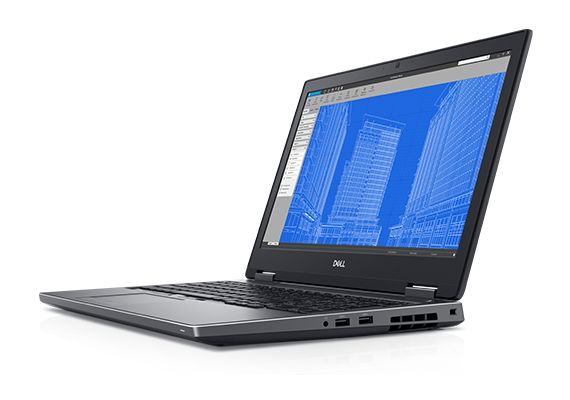Engineering on the Go with Mobile Workstations

The new Dell Mobile Precision 7730 is ready for VR. Image courtesy of Dell.
Latest News
July 16, 2018
Workstation-class computers continue to gain in sales, while consumer and enterprise PC markets continue to shrink. The workstation market volume hit another record high of 1.3 million units, reflecting a year-to-year growth of 5.4%, according to Jon Peddie Research (JPR). The growth shows that workstation buyers, such as those on design engineering teams, need the advancements new workstation models provide in order to keep up with on-the-job demands for increased productivity and shorter deadlines.
Increasingly, those jobs are mobile—whether traveling for business, taking work home or collaborating with colleagues on the other side of town. In 2017 mobile workstation sales grew even faster than desktops, according to JPR.
“Professionals are more mobile than ever,” says Scott Hamilton, a Dell workstation market specialist. “They need powerful systems they can take on the go. Engineers specifically are spending more time in the field, whether working from a home office or at different job sites.”
Customers want both portability and power, but what has changed is the performance specs of mobile units. Thin and light no longer means a lack of power or a short battery life. The latest portable hardware, such as the new Dell Precision 7530 (15-in.) and 7730 (17-in.) mobile workstations feature enough power for virtual reality. The new workstations support the latest CPUs, NVIDIA Quadro professional graphics, 3200MHz SuperSpeed memory, and have the largest memory capacity for a mobile workstation—up to 128GB, according to the company.
Breaking Moore’s Law
There is talk in the computer industry that using Moore’s law to describe computer performance growth is an outdated notion. Raw growth in number of transistors is not a valid measurement, the thinking goes. Instead, the argument goes, look to other improvements, such as support for error-correcting code memory, higher core counts and support for greater amounts of RAM. However, graphics processing unit (GPU) vendors are packing more transistors and more performance power into smaller footprints with every product update.
Professional rendering software is now embedded into many MCAD products, notes Andrew Rink, head of AEC and manufacturing industry marketing strategy at NVIDIA. “Designers have increasingly been exposed to fast, easy-to-use rendering; its use is growing quickly,” he says. The latest hardware and software means you don’t have to wait for renders to catch up with your design process. Graphics cards like the NVIDIA Quadro P5200, which has 2,560 CUDA parallel-processing cores, are available for mobile workstations.
Real-Time Simulation Pushes the Envelope
Engineering graphics are moving beyond the flat screen with an explosion of new use cases. Virtual reality and augmented reality have become a necessary extension of product development. Engineers are using VR as a prototyping environment, to view fully functional—albeit virtual—products before they are built. Internet of things applications, parts created with 3D printing and autonomous vehicles all benefit from real-time visualization as part of the engineering process.
These new domains are computationally intensive. Consider design review of an airplane in virtual reality. The workstation must deliver 90 frames per second (fps) of high-quality graphics in real-time response to the observation and movement of the VR user who is wearing a head-mounted display; the field of view can change unpredictably at any time. That is almost eight times as much graphics throughput than required to put a 3D CAD model on a flat display. Still, high-end mobile workstations are up to the task.
 Discovery Live can seamlessly switch between fluid flow and thermal analysis displays, all on the same model. Image courtesy of ANSYS.
Discovery Live can seamlessly switch between fluid flow and thermal analysis displays, all on the same model. Image courtesy of ANSYS.With the recent release of ANSYS Discovery Live, engineers can now access real-time engineering simulation on mobile workstations. This CAD agnostic CUDA-based software requires a minimum 4GB of GPU V-RAM, although ANSYS recommends 16GB of frame buffer. Rink says, “I’ve seen outstanding interactive performance when analyzing modifications for aerodynamics simulation on a large commercial truck model using the NVIDIA Quadro P5000 in a mobile workstation.” He believes engineers will take advantage of using Discovery Live while working away from the office to quickly evaluate design modifications as they iterate on early stage product development.
Other Mobile Workstation Trends
We all use a finger or a stylus to navigate our smartphones and tablets. But within product development, that sort of input has been limited to early-stage industrial design. But things are changing. SOLIDWORKS 2018 supports pen-based workflow, for example; so do various apps in the CATIA ensemble. Siemens Solid Edge and NX units work closely with Microsoft on its Surface technology. In 2018 all the leading mobile workstation vendors will offer more options for pen and touch user interaction, starting with various thin-and-light ultrabook models where touch interaction is a market expectation.
Other market trends that will affect mobile workstations include:
- More RAM to handle larger, more complex CAD models,
- Storage without moving parts: The transition away from optical drives is nearly complete—and mechanical hard drives are not far behind. The new technology standard for solid-state drives (SSD) is non-volatile memory express (NVMe). Like SCSI and SATA for mechanical drives, NVMe takes better advantage of the data pipeline. NVMe improves on previous data storage specifications by only requiring a single message for a 4KB data transfer (instead of two messages). Older standards processed one data queue at a time; NVMe can process 65,536 at a time. The bigger the engineering model, the more back and forth takes place between RAM and storage. Engineers who upgrade to a mobile workstation using NVMe will notice a substantial performance improvement.
- Thunderbolt connectivity: Shop carefully if you have a preference for device connections beyond Thunderbolt. Older standards including HDMI or USB are on the wane in mobile workstations as Thunderbolt becomes an industry standard.
Subscribe to our FREE magazine, FREE email newsletters or both!
Latest News








